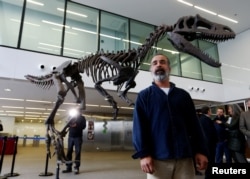A newly discovered meat-eating dinosaur that prowled Argentina 90 million years ago would have had a hard time using strong-arm tactics against its prey. That's because the beast, though a fearsome hunter, possessed a pitifully puny pair of arms.
Scientists said Wednesday that they had unearthed fossils in northern Patagonia of a two-legged predator called Gualicho shinyae that was up to 26 feet (8 meters) long but had arms of only about 2 feet (60 centimeters).
The fossils of Gualicho, named after an evil spirit feared by Patagonia's indigenous Tehuelche people, were discovered in Argentina's Rio Negro province.
Gualicho and other carnivorous dinosaurs like Tyrannosaurus rex are part of a group called theropods that included Earth's largest-ever land predators. But a curious thing happened during their many millions of years of evolution. For some, as they acquired huge body size and massive skulls, their arms and their number of fingers shrank.
Gualicho had feeble forelimbs and only two fingers, just like T. rex, which lived in North America almost 25 million years later. The earliest dinosaurs had five fingers.
Paleontologist Peter Makovicky, curator of dinosaurs at the Field Museum in Chicago, said Gualicho's short, two-fingered forelimbs strongly resembled those of some members of a theropod group called tyrannosaurs including T. rex, even though Gualicho was only distantly related to them.
"Gualicho did not inherit this forelimb anatomy from an ancestor it shared with tyrannosaurs. Rather, it evolved independently in the two groups," Makovicky said.
Gualicho lived during the Cretaceous Period, the final chapter in the dinosaurs' reign. Many big Cretaceous meat-eaters had evolved immense skulls studded with formidable teeth, relying on these for hunting, rather than arms.
Gualicho lived in a forested flood plain environment alongside some of the biggest dinosaurs ever, including long-necked, four-legged plant-eater Argentinosaurus, about 115 feet (35 meters) long, and T. rex-sized predator Mapusaurus, about 41 feet (12.6 meters) long.
"Gualicho would likely not have been something you'd want to meet on a lonely, dark Cretaceous night," said Makovicky, whose research was published in the journal PLOS ONE.
"With Mapusaurus probably preying on large sauropods [the group that included Argentinosaurus], Gualicho likely focused on smaller prey — a category a human lost in the Cretaceous would fit into."












